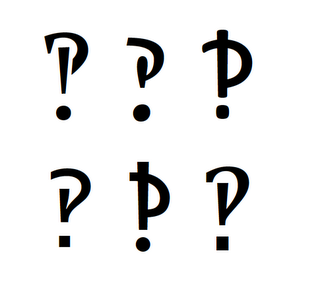Emphatic !? question?!

To the delight of font-dweebs and typography mavens everywhere, it is apparent that the "interrobang" glyph is being seen more often now in font libraries and thereby may find its way into magazine pages.
The interrobang combines the exclamation mark and the question mark in one and was developed in 1962 by Martin Speckter with the intention of conveying additional information for advertising text.
This item from fontblog, indicates that Microsoft has begun to include the little character in its Clear Type font collection. (Unfortunately, the fonts used for this blog do not contain it.) Here's what Wikipedia says about the interrobang.
5 Comments:
I find it perplexing (and worrisome) that you refer your readers to Wikipedia as a source of information on a subject- I understand that the general public is easily swayed into believability by anything labelling itself "pedia," but I would hope that anyone in the media would be a more critical and aware of what constitutes a reliable source of information (and would have some interest in upholding standards of accuracy and reliability). An open-source encyclopedia? May as well go ask the guy on the street.
I'm sorry to have offended. I guess, in a sense, an "open source" encyclopedia is a contradiction in terms. I would never use it for a biography, but for a mundane fact such as this? I'm not so bothered. The definition seemed reasonable and I couldn't find it in my Penguin English Dictionary (the one I had to hand).
Wikipedia rocks. Absolute truth is soooo passé. Everything is relative. What matters is what's interesting.
[grin]
Truth is largely a human construct, and if you get enough people together who agree that 2+2=5, then *PRESTO!* 2+2 does equal 5.
I think that's what Wikipedia is good at. Just check out any of the discusssions on just about any obscure Wikipedia page and you'll find a lot of people who care about that trivial thing, and who are determined to get to the nub of the matter. (And a few with an axe to grind, thrown in for good measure.) Way cool.
One guy on the street = a focus group of one.
Thousands of people, self-selected because they know enough about something because they care about it = a reasonable approximation of truth.
Hey, d. b. You're right that Wikipedia is not to be trusted on traditional "facts" although it usually does get a majority of them right. As an open-source reference it is too-easily subject to arbitrary and incorrect input. However, the input is also traceable and correctable. I like JS's lighthearted wink at the subject, but I fear he went too far in equating group-think with fact. You did the right thing by referencing your source, which allows us to judge how much weight to give the blog entry. No harm done. And I learned about something that is as old as I am and yet I had never heard of it. Thanks.
Generally, sources are no more or less reliable than the person using them. If you take the time to cross-reference, seek out alternate sources, and analyze critically, in the end you'll end up with a very reliable set of facts; if you just rely on one entry -- either from Wikipedia or whatever dusty leather-bound doorstopper you've got lying around -- then you're hanging your credibility on a pretty weak peg.
See this article from Respected, Authoritative Academic Journal Nature on a comparison of Wikipedia and Britannica. Wikipedia makes a pretty easy target for technophobes, but in the end, it doesn't have more weaknesses than traditional encyclopediae, just different ones.
Post a Comment
Subscribe to Post Comments [Atom]
<< Home